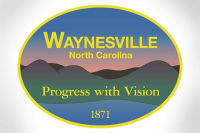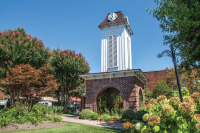Wal-Mart rolls out unique design
The controversy over a proposed Super Wal-Mart complex in Waynesville took a turn at a town planning board meeting this week when developers presented a design for the store’s façade that by all accounts was the nicest looking Super Wal-Mart anyone had ever seen.
Waynesville’s three-year-old land-use plan was intended to protect the town’s unique mountain character and guard against cookie cutter big box developments. The developers of the Super Wal-Mart complex, appealed to the town for exemptions to the some of the tougher standards. But town aldermen, the town planning board and town community appearance commission sent a loud and clear message in a series of meetings with developers that if they wanted to come to Waynesville, their store needed to blend in with the community and be pedestrian friendly. A big cinderblock box was not acceptable to the town.
The developers were seeking several exemptions to the land-use plan, such as sign height, architecture standards and planting trees along the building façade. Realizing they needed to satisfy the town’s demand for an attractive building façade if they wanted the other exemptions, their architects got to work on a design. First, they toured several buildings in town that the town community appearance commissioner cited as examples of well-designed buildings, including the new sheriff’s office and Haywood Vocational Opportunities. The community appearance commissioner specifically requested the use of local materials, such as stacked stone, brick and timbers.
The design Wal-Mart’s architects, Perkowitz and Ruth, came back with has a brick façade and a stacked stone entryway. Long blank walls are broken up with stacked stone columns and some areas of windows providing texture rather than a flat solid wall. The entrances to the garden center, main store and grocery store protrude, creating depth rather than a solid plane for the 500-foot-length of the building facade. The façade also features a couple of pitched roofs with wooden timbers over each entrance.
“Normally we don’t do that kind of detail. It really makes it more unique,” said Justin Eder, design manager for Wal-Mart’s architect firm. “It will assimilate with the community. It has a rustic feel to it.”
The design even impressed some of the stiffer critics of the project who had vocally opposed granting Wal-Mart exemptions to the town’s land-use plan during previous meetings.
Related Items
“That’s what we are looking for, to satisfy local residents,” Eder said.
Planning board members who were slated to vote on the exemptions were impressed as well.
“I’d like to say the (town planning) staff has done a good job holding the developers to what we really need in this area,” said Dan Wright, a planning board member, upon seeing the design. “I think that area of town, South Main Street, is in dire need of improvement something like this designed well and built well that will set the tone for that end of tone.”
The complex proposed for the former Dayco factory site will also include a Home Depot, a Staples and a collection of smaller to-be-determined stores. Home Depot also presented an artist’s rendering of a building façade. It, too, incorporates stacked stone in the building façade and stacked stone columns at the entrance. While clearly in the above-average category, it did not draw the same kind of praise as the Super Wal-Mart design.
Upon seeing the design, the town planning board unanimously approved the other exemptions the developer is seeking from the land-use plan. The designs presented by Super Wal-Mart and Home Depot are not set in stone, however. Right now, the developers are merely seeking the exemptions they need for the overall site plan. Once those are secured, they will go through the process of getting a building permit, at which point they will formally present a building design for approval.
What was decided:
The Waynesville planning board this week approved some exemptions to the town’s land-use plan for a proposed Super Wal-Mart and Home Depot. The final decision rests with the town board, which will consider the issue in September, but here’s a look at what the planning board agreed to.
What community gets
• The perimeter of the complex along South Main Street and Hyatt Creek Road will have sidewalks and street trees.
• Entrances off South Main and Hyatt Creek will have sidewalks and street trees on both sides of the entry road.
• No parking space will be further than 30 feet from a tree.
• Store design that doesn’t meet the exact letter of the land-use plan, but at least upholds the spirit of the land-use plan.
What developers get
• A 25-foot tall, 150-square foot sign at each entrance opposed to the 4-foot cap on signs in the land-use plan.
• Exemption from tougher architectural standards.
• Instead of 8-foot-wide landscaped islands in the parking lot, the developer can do 5-foot-wide islands to free up more room for parking.
• Doesn’t have to plant a row of trees directly in front of the building façade.









